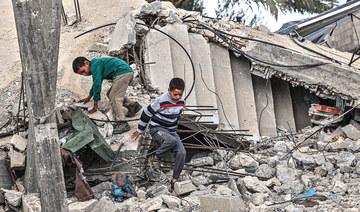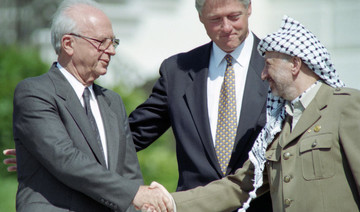TEHRAN, Iran: Iran is bracing for the restoration of US sanctions on its vital oil industry next week, as it grapples with an economic crisis that has sparked sporadic protests over rising prices, corruption and unemployment.
The oil sanctions, set to take effect on Monday, will target the country’s largest source of revenue in the most punishing action taken since the Trump administration withdrew from the 2015 nuclear agreement in May, and will also affect Iranian shipping and financial transactions.
The United States has already restored sanctions on Iran targeting financial transactions involving US dollars, Iran’s automotive sector and the purchase of commercial airplanes and metals, including gold.
The White House insists the sanctions are not aimed at toppling the Islamic Republic, but at forcing Iran to dramatically alter its policies in the region, including its support for militant groups across the Mideast and its development of ballistic missiles. The UN nuclear agency says Iran is complying with the nuclear deal.
The renewed sanctions have already taken a heavy toll, with the rial losing half its value since April and the prices of fruit, poultry, eggs and milk skyrocketing. Protests erupted across the country in December, with some demonstrators chanting against the government and clashing with police. Sporadic demonstrations have been held in recent months, including strikes by workers, teachers and truck drivers.
The nuclear accord struck under the Obama administration — and also signed by Britain, France, Germany, China and Russia — lifted crippling international sanctions in exchange for Iran curbing its nuclear program. Western countries had long suspected Iran’s nuclear program masked the covert pursuit of atomic weapons, allegations denied by Iran, which has always insisted its nuclear activities are for energy and other peaceful purposes.
After the agreement took effect in 2016, Iran began exporting its oil more freely and signed billion-dollar agreements with Airbus, Boeing and other Western firms. But the legacy of decades of sanctions and economic mismanagement remained, and the nuclear deal’s future was thrown into uncertainty with the election of President Donald Trump, who had repeatedly vowed to exit the deal and finally withdrew in May.
Starting Monday, the Trump administration has promised that companies that fail to comply with the sanctions will be barred from doing business in the US Although Washington might grant waivers to countries like China and India, which are among the biggest importers of Iranian crude, the expectation is that the US will demand substantial curbs on how much is imported.
In recent weeks, Iran’s President Hassan Rouhani had tried to reassure the public, saying the worst has already come to pass and that the government is working on ways to evade the new sanctions. But in a televised Cabinet meeting on Wednesday, he acknowledged that “the situation was hard for people in recent months, and it may be hard in the next several months, too.”
“The government will utilize its entire capabilities to alleviate the problems,” he added.
In an effort to circumvent the sanctions, Iran began selling some of its oil in an energy stock exchange on Sunday. Iran’s Oil Minister Bijan Zanganeh said 280,000 barrels were sold on the IRENEX exchange as of Wednesday and that 720,000 barrels will be provided later.
But the 1 million barrels a day Iran intends to sell in the exchange — which foreign dealers can access — is a fraction of the peak 2.5 million barrels a day that Iran sold before the Trump administration announced the re-imposition of sanctions.
European countries, which remain committed to the nuclear deal, have discussed taking measures that would shield European companies from the US sanctions and allow them to keep doing business in Iran. But thus far they have been unable to prevent an exodus of major firms, including Boeing and Airbus, which suspended the aircraft purchases. General Electric, Maersk, Peugeot, Renault, Siemens, and Total have also canceled business deals in Iran, according to the Washington-based Atlantic Council.
Despite the unraveling of the nuclear deal, Iran is still complying with it, and appears to be waiting out Trump, hoping his successor rejoins the agreement.
In the meantime, the renewed sanctions risk further undermining Rouhani, a relative moderate, and strengthening hard-liners distrustful of the West, the International Crisis Group said in a report this week.
“The alternative to both sides taking a step back from the escalatory path is a sanctions regime that penalizes Iran and the Iranian people, but does not enhance peace and security in the region and could well lead to war.”
Iran braces for oil sanctions after currency crash, protests
Iran braces for oil sanctions after currency crash, protests
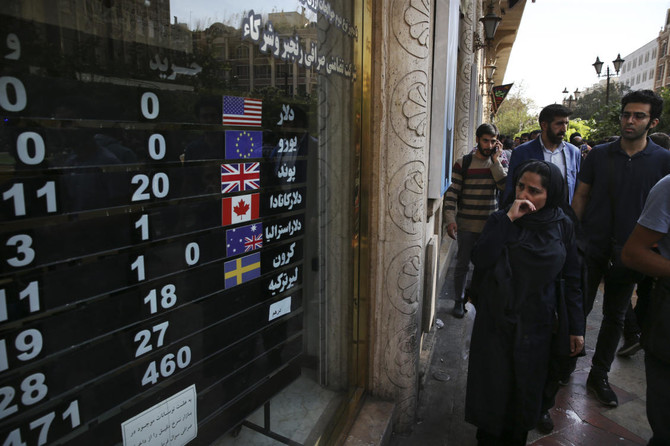
- The oil sanctions, set to take effect on Monday, will target the country’s largest source of revenue
- In an effort to circumvent the sanctions, Iran began selling some of its oil in an energy stock exchange on Sunday
Netanyahu says ending Gaza war now would keep Hamas in power

- Israeli leader hardens his rejection of Hamas demands for an end to the Gaza war in exchange for the freeing of hostages
Netanyahu said Israel was willing to pause fighting in Gaza in order to secure the release of hostages still being held by Hamas, believed to number more than 130.
“But while Israel has shown willingness, Hamas remains entrenched in its extreme positions, first among them the demand to remove all our forces from the Gaza Strip, end the war, and leave Hamas in power,” Netanyahu said.
“Israel cannot accept that.”
“Hamas would be able to achieve its promise of carrying out again and again and again its massacres, rapes and kidnapping.”
In Cairo, Hamas leaders held a second day of truce talks with Egyptian and Qatari mediators, with no apparent progress reported as the group maintained its demand that any agreement must end the war in Gaza, Palestinian officials said.
The war began after an assault by Hamas on southern Israel on Oct. 7 in which 1,200 people were killed and 252 hostages taken, according to Israeli tallies.
Israel’s ensuring military offensive has killed more than 34,600 Palestinians, according to the health ministry in the Hamas-ruled Gaza. The bombardment has devastated much of the coastal enclave and caused a humanitarian crisis.
‘Substantial progress’ in Cairo talks on Gaza truce

- Hamas delegation, Egyptian mediators discuss prospects for truce in war-riddled Gaza
- Israel has killed over 34,650 Palestinians in Gaza, wounded over 77,000 since Oct. 7
CAIRO: Talks in Cairo involving a Hamas delegation and Egyptian mediators have made substantial progress toward achieving a ceasefire in Gaza, according to a high-ranking source.
The source, who preferred not to be named, told Cairo News Channel that Hamas representatives and an Egyptian security delegation have reached consensus on many contentious points.
Hours before the Hamas delegation’s arrival in Cairo on Saturday, Gen. Abbas Kamel, chief of Egypt’s General Intelligence Directorate, received a phone call from the movement’s leader, Ismail Haniyeh, concerning the negotiations.
Security and political expert Ahmed Mustafa told Arab News: “According to my information, Hamas has agreed to the first phase of the ceasefire deal in Gaza.
“This includes the release of a number of hostages, with the assurance that Israel will fully withdraw from Gaza after 124 days, upon completion of the three stages of the major agreement being coordinated here in Cairo.”
Mustafa also said the Hamas delegation in Cairo is expected to inform the Egyptian side of its agreement with only minor amendments.
“I believe that Hamas has agreed on some terms with the Egyptian mediators now, and previously with the Qatari mediators under American guarantees,” he said.
However, Mustafa said that Israel’s refusal to end the war in Gaza as part of any hostage deal and its determination to eliminate what remains of Hamas remain “major points of contention.”
According to Mustafa, another point of disagreement concerns allowing the entry of dual-use materials into the enclave, for example humanitarian supplies that could also be used for combat purposes, such as fuel.
He said that the first phase, which Hamas “has tentatively agreed upon, will last up to 40 days, during which up to 33 of more than 100 Israeli hostages held in Gaza since Oct. 7 will be released.”
The second phase will last at least six weeks, with both sides agreeing to release a larger number of hostages and prisoners, and also committing to a longer halt to the fighting.
Aboud Jamal, a researcher on Palestinian affairs, told Arab News: “Hamas announced on Friday evening that settlements had been reached, and a delegation from the movement would head to Cairo on Saturday to secure an agreement in a way that meets the demands of the Palestinians.”
Jamal added: “It is clear that the coming days will witness an agreement to cease fire along with the release of some Israeli hostages.
“The only remaining issue is the stance of the Israeli government, which seems to want to prolong the war to maintain (Benjamin) Netanyahu’s government following the recent protests against him in Israel.”
Jamal said the Israeli government stands to benefit by obstructing any agreement.
“So, by sending its delegation to Cairo and discussing its agreement to terms in the prospective deal through mediators, Hamas has preempted the Tel Aviv government, a move for which the movement’s leaders are to be commended.”
He added: “It appears that Egypt truly stands with the Palestinian people and is supportive of reaching an agreement that ensures a ceasefire to save what can be saved of the lives of Gaza’s residents.
“This was evident from the statement issued by Hamas before its security delegation headed to Cairo, stating that Hamas leader Ismail Haniyeh appreciates the role that Egypt is playing.”
Tunisian town gripped by exodus of youth seeking better life in Europe

- The struggling town of El Hencha is just 150 kilometers from the Italian island of Lampedusa, a gateway for migrants to Europe
EL HENCHA, Tunisia: When Mohamed Lafi vanished at sea one fateful night, it marked yet another tragedy for a Tunisian town struggling with the exodus of its youth.
Mohamed’s disappearance adds to the deepening despair in El Hencha, situated just 150 kilometers (90 miles) from the Italian island of Lampedusa.
His sister, Ines, stayed behind, confronting the harsh reality that many families face as their loved ones risk everything in search of a better life in Europe.
Mohamed, a 30-year-old taxi driver, left home on the night of January 10 with little more than his mobile phone.
“He went without saying anything to my parents, without a change of clothes, or a bag,” said Ines, 42.
It seemed as though he “was going to meet his friends,” she said.
Mohamed was one of 40 would-be migrants who had boarded a boat — all Tunisians aged between 17 and 30, including a woman and her four-month-old baby.
Despite adverse weather conditions and rough seas, they were determined to set sail, their families said.
More than 1,300 migrants died or disappeared last year in shipwrecks near the Tunisian coast, said the Tunisian Forum for Social and Economic Rights (FTDES) non-governmental organization.
In 2023, Tunisians accounted for the second largest number of irregular migrant arrivals in Italy, at 17,304 people, second only to Guineans at 18,204, Italian government official figures show.
The European Union signed an agreement last year to provide financial aid to debt-ridden Tunisia in return for its commitment to curb migrant departures.
The sense of hopelessness is palpable in Tunisia, whose economy is stagnant with only 0.4 percent of growth in 2023 and unemployment hovering around 40 percent.
The north African country has also been shaken by political tensions, after President Kais Saied orchestrated a sweeping power grab in July 2021.
Those missing from El Hencha, mainly from the middle class, shared a grim outlook for the future, said FTDES.
“Irregular migration cannot be explained only by economic and social factors,” said Romdhane Ben Amor, spokesman for the rights organization.
“The political factor and the feeling of despair of Tunisians who don’t believe in the future of the country” also play a significant role, he added.
Meftah Jalloul, the father of another young migrant, was aware of his son Mohamed’s longing to cross the Mediterranean for a brighter future.
The 62-year-old fishmonger had pleaded with Mohamed to wait for better weather before embarking on his journey.
But the 17-year-old, intent on making the perilous voyage, simply kissed his father on his head and left.
“He wanted money to migrate,” said Jalloul, taking responsibility for providing the funds.
With daily earnings of 20 dinars (about $6), Mohamed Lafi was left with little prospects for building a stable future, said his sister Ines.
“He was unable to make plans or build a house or get married,” she lamented.
Yousri Henchi, a 22-year-old migrant, dropped out of high school and earned a meagre income of 10 to 15 dinars a day working at an Internet cafe.
His uncle, Mohamed Henchi, attributed the allure of Europe to frustrated youths like Yousri being influenced by successful migrants who shared their experiences on social media.
“They see that and want to change their future. They see Europe as a paradise,” he said.
Jalloul had sought to persuade his son, who also quit high school, to undergo vocational training and migrate legally to Italy, France, or Germany.
“He shouldn’t have left without skills or qualifications,” he said. “He could have learnt a trade — plumbing, carpentry, or mechanics.”
Jalloul clings to the hope that the boat Mohamed boarded drifted toward neighboring Libya, although searches there by family contacts have yielded no leads.
“Four months have passed and I am still crying for my son,” he said, overcome with emotion.
Ines Lafi expressed anger toward the person who smuggled her brother’s group, a figure well-known in El Hencha for facilitating clandestine crossings to Italy.
“He had always come back here, but this time, he disappeared without a trace.”
The families have urged Tunisian authorities to bolster economic conditions, educational programs and cultural activities in the town of around 6,000 people to encourage youths to stay.
“We must enhance the industrial zone and create job opportunities for young people,” said Henchi.
Why the Oslo Accords failed to put Palestinians on the path to statehood

- A memento being offered for sale was apparently torn from White House program for the Sept. 13, 1993, signing ceremony
- Timing of sale amid Gaza war ironic in that the document is reminder of a conflict that has raged unresolved since 1948
LONDON: Monday, Sept. 13, 1993, was a sunny day in Washington and, for those gathered on the lawn of the White House, it seemed that a bright new era had dawned in the fraught relationship between Israel and the Palestinians.
The occasion was the formal signing of the Oslo Accords, a declaration of principles on interim Palestinian self-government that had been agreed in the Norwegian capital the previous month by Israeli and Palestinian negotiators.
It was a historic moment, and it produced a remarkable photograph that claimed its rightful place on the front pages of newspapers around the world: Israeli Prime Minister Yitzak Rabin and PLO Chairman Yasser Arafat smiling and shaking hands in front of a beaming US President Bill Clinton.

With ironic timing, given the current tragedy unfolding in Gaza 30 years later, a unique memento of that day is being offered for sale by the Raab Collection, a US company that specializes in the buying and selling of important historical documents and autographs.
The single piece of paper, embossed with the golden seal of the President of the United States, and apparently torn from the White House program for the signing ceremony, is signed by all the key players on that hopeful day.

According to Raab, which declines to reveal who put the document up for sale, it was “acquired from the archives of one of the important participants at the event.”
Each of the seven signatures has great value for any student of politics and history — here are the hands of Arafat, Rabin, Palestinian President Mahmoud Abbas, Israeli President Shimon Peres, US Secretary of State Warren Christopher, and Russian Foreign Minister Andrei Kozyrev, whose country had co-sponsored the 1991 Madrid Conference that set the stage for the Oslo Accords.
Taken together, they offer a bittersweet reminder of a moment when, in the words that day of an ebullient Clinton, “we dare to pledge what for so long seemed difficult even to imagine: That the security of the Israeli people will be reconciled with the hopes of the Palestinian people and there will be more security and more hope for all.”

Rather like a rare stamp, the value of which is increased by a printing anomaly, the document includes a curious discrepancy. It was signed on Sept. 13, the day of the White House ceremony, but only two of the signatories added the date to their signature. While Abbas wrote the correct date, the 13th, Arafat dated his signature the 14th.
The document is offered for sale at $35,000, but in political terms, with the hope expressed that day by Clinton that it was the gateway to “a continuing process in which the parties transform the very way they see and understand each other,” it is worthless.
INNUMBERS
• 10 Israeli prime ministers since the signing of the Oslo Accords in 1993.
• 4 Palestinian prime ministers since creation of the post in 2013.
As a reminder of the seemingly intractable nature of a conflict that has raged unresolved since 1948, the 30-year-old document is priceless.
One of the witnesses on the White House lawn that September day in 1993 was philosopher Jerome M. Segal, a peace activist who in the spring of 1987 had been part of the first American-Jewish delegation to meet with the PLO leadership.

The following year Segal played a key role in negotiations that led to the opening of a dialogue between the US and the PLO, and a series of essays he published is credited with having informed the PLO’s decision to issue a Declaration of Independence and launch a unilateral peace initiative in 1988.
In 1993, as he watched Arafat and Rabin shaking hands, Segal, the founder of the Jewish Peace Lobby, had good reason to think that the elusive prize of peace might actually be within grasp.
Four days before the signing, Arafat and Rabin had exchanged letters, the former renouncing violence and acknowledging Israel’s right to exist in peace and security, and the latter recognizing the PLO as the representative of the Palestinian people and committing to peace negotiations.

It was agreed that a new Palestinian National Authority would be formed, and would assume governing responsibilities in the West Bank and Gaza Strip.
After five years, “permanent status” talks would be held to forge agreement on key issues to pave the way for the creation of a future Palestinian state, including borders, the right of return of Palestinian refugees, and the status of Jerusalem.
But Segal, and everyone else imbued with optimism on that bright September day, was to be disappointed.

Many reasons have been proposed for the withering of the olive branch of Oslo, but according to Israeli-British historian Avi Shlaim, writing in 2005, “the fundamental cause behind the loss of trust and the loss of momentum was the Israeli policy of expanding settlements on the West Bank, which carried on under Labour as well as Likud.”
This policy — which continues to blight relations between Israel and the Palestinians to this day — “precluded the emergence of a viable Palestinian state, without which there can be no end to the conflict.”
In a terrible pre-echo of the provocative visits to the Al-Aqsa mosque compound carried out recently by some of the right-wing members of Benjamin Netanyahu’s cabinet, Ariel Sharon, while campaigning to become Israel’s prime minister in September 2000, made a similarly controversial visit to the site.

The result was an outbreak of violent protests by outraged Palestinians. The Second Intifada would last almost five years and claim thousands of lives.
For Segal, director of the International Peace Consultancy, the failure of Oslo owes less to the supposed intransigence of the PLO over the years than to the internal dynamics of Israeli politics.
“The thing to realize about Oslo is that since 1993, the Palestinians have had only two leaders, Arafat and Abu Mazen (Mahmoud Abbas, the second and current president of Palestine),” he told Arab News.
“Their positions on final status were almost identical, so there has been a consistency on the Palestinian side of a willingness to end the conflict and recognize the State of Israel — even through the Second Intifada, that never changed, and it’s still there today.
“But on the Israeli side, we’ve had enormous flip-flops, from Rabin, to Peres, to Netanyahu, to Ehud Barak, to Ariel Sharon, to Ehud Olmert, and back again to Netanyahu.”
The precarious nature of peace talks for Israeli politicians was underlined in November 1995 when, just two years after shaking Arafat’s hand, Rabin was assassinated by a right-wing Israeli extremist opposed to the Oslo Accords.

“After Rabin’s death we have only had two Israeli prime ministers, Barak and Olmert, who have gone into serious final-status negotiations with the Palestinians,” said Segal.
Barak, who beat Netanyahu in the polls by a wide margin to become prime minister in 1999, “did it in a terrible context — the Second Intifada had already started.”
In 2000, Barak took part with Arafat in the Camp David Summit, which ended without agreement. As the violence continued in 2001, Barak stood for reelection as prime minister, losing to Ariel Sharon, one of the founders of Israel’s right-wing Likud party.

In 2006, Sharon was succeeded by Ehud Olmert, leader of the more liberal Kadima party. By 2009 he too would be gone, enmeshed in a series of corruption allegations and succeeded by Netanyahu.
“So, in the entire period since 1993, we’ve actually had only two Israeli prime ministers, and for a combined total of not more than three years, under whom there was a serious effort to pursue the final negotiations envisioned by Oslo,” Segal said.
That, he added, “leads to a very interesting question: Why, with the promise of ending the conflict, does the Israeli public regularly elect prime ministers who aren’t interested, like Netanyahu — why, as I heard Avi Gill (a former director-general of Israel’s Ministry of Foreign Affairs) put it, do Israelis poll left, but vote right?”

The answer, Segal believes, “is because they don’t believe they are losing anything by doing so.”
Ironically, given the unwillingness of every Israeli leader since Olmert to compromise in the interest of peace, “even though they would support the two-state solution, they don’t believe there’s a Palestinian partner who will. In their mind they’re not losing a conflict-ending agreement they might get if they had a left-wing leader, so they end up going for Mr. Security.”
This, believes Segal, is a crucial factor in the ongoing failure to find the peace that seemed so close in 1993.
“You have to deal with this, what I call ‘no-partnerism,’ the dogma that there is not, and has never been, a Palestinian partner for peace, because this is not just a Netanyahu thesis. It’s one that’s deep in the belief structure of the majority of Israelis.
On Oct. 6, the eve of the Hamas-led attack on Israel, Segal was optimistic that a breakthrough was close.
In his book “The Olive Branch from Palestine,” published in 2022, he had urged “a Palestinian return to unilateral peacemaking, with the Palestinians taking the lead in establishing ... a UN commission through which the Palestinians would advance, in full detail, without any ambiguity, the end-of-conflict, end-of-claims agreement that they are prepared to sign.”

This he dubbed UNSCOP-2, an allusion to the UN committee formed in 1947, which proposed the original partition plan for Palestine.
“On Oct. 6, I believed that we could get major changes through the UNSCOP-2 process. I believed that a committee could be created in a matter of months, that all I had to do was to get Abu Mazen across the line, to get him to go from calling on the secretary general of the UN to do something to doing something himself in the General Assembly, and we could move very rapidly.
“We talked to many countries at the UN. We even talked to Iran, and nobody was opposed. I believed that we could then put in front of the Israeli public something that in decades of conflict they have never had, which is a Palestinian ‘Yes’.”
By training a philosopher, Segal remains philosophical, despite the disastrous events of the past seven months.
“On Oct. 6, I was optimistic for the short term. Now I see the timeframe is very different, but I do have proposals. Our approach after Oct. 7 is what you could call ‘Gaza-first’.”

This is the reawakening of a plan first proposed by Segal in 1995 at the request of Israeli Prime Minister Peres — the idea that while granting Palestinians sovereignty over the West Bank might be an initial step too far for most Israelis, an experiment in Palestinian statehood limited at first to Gaza might win their confidence and, ultimately, lead to an Arab state that includes the West Bank.
In 1995, it was Arafat who rejected the plan, fearing not unreasonably that “Gaza first” would come to be “Gaza last,” with the PLO confined to the coastal strip in perpetuity, even though “I presented a 20-point proposal designed to give the PLO confidence that they wouldn’t get stuck in Gaza.”
The reason, Segal believes, is because Oslo was still alive, and it made sense for the PLO to hold out for what would prove to be the illusory promise of final-status talks.
Now his view is that “Gaza first” offers the only realistic hope of progress.
As he wrote in a column for Foreign Policy on Feb. 6, in the wake of Oct. 7 “no Israeli government will ever agree to a Palestinian state in the West Bank unless there is substantial confidence that it will not be a threat to Israel.”
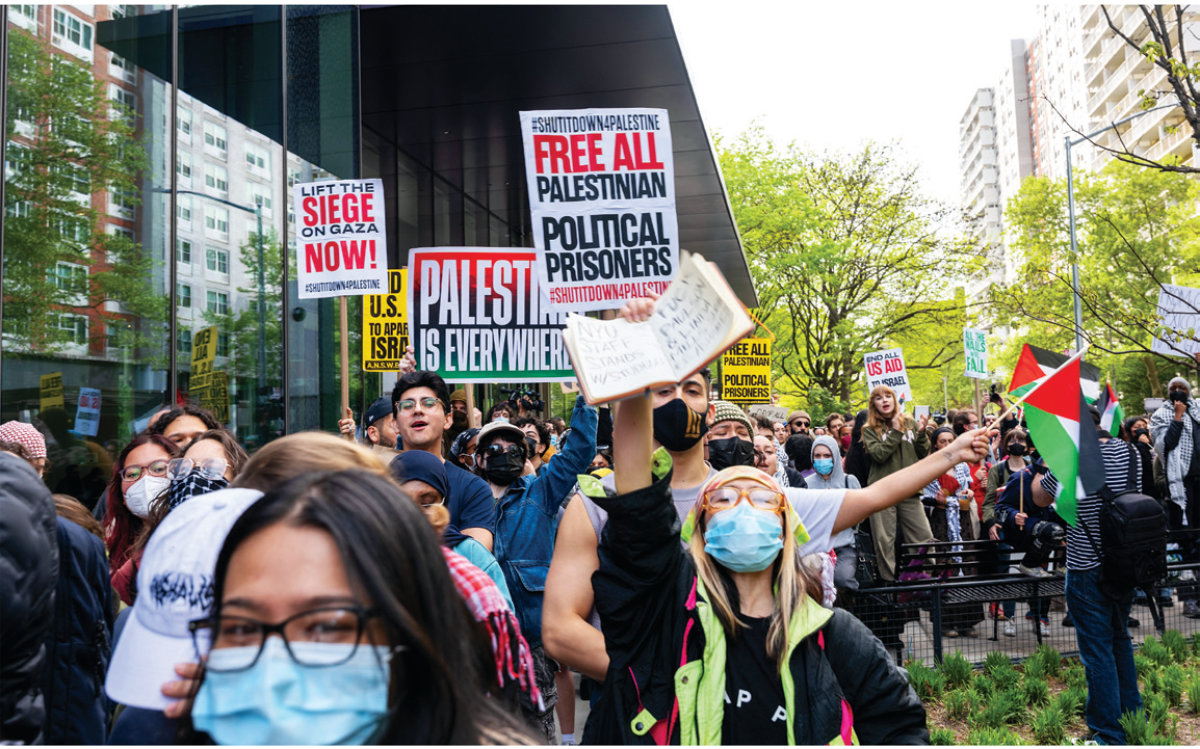
If there is an answer, Segal concluded, “it will require abandoning the defunct Oslo paradigm, which sees Palestinian statehood emerging as a result of successful end-of-conflict negotiations.
“The alternative is a sovereignty-in-Gaza-first approach, to test Palestinian statehood in Gaza first and, only if it is successful over an agreed period, to then move to negotiations on extending Palestinian sovereignty to the West Bank.”
Right now, Segal’s dogged commitment to the peace process is as admirable as it is remarkable.
But, in the face of a general lack of alternative proposals, it perhaps also offers the best hope of achieving Clinton’s wish, expressed on the White House lawn over 30 years ago, that “two peoples who have both known the bitterness of exile” might “put old sorrows and antagonisms behind them ... to work for a shared future shaped by the values of the Torah, the Qur’an, and the Bible.”

Israeli official says Hamas demand for end to war ‘thwarting’ truce efforts
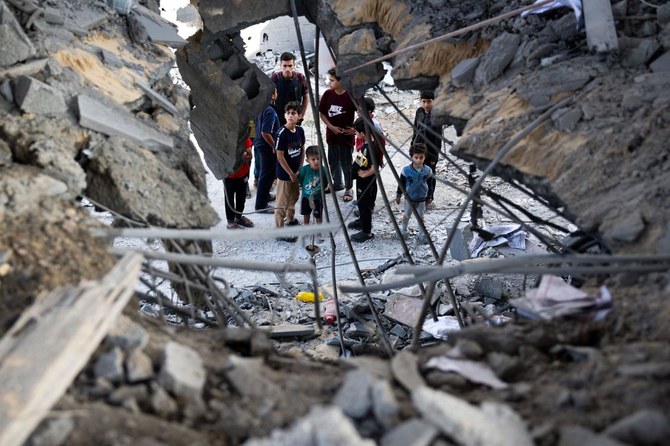
- The official rejected reports that Israel had agreed to end the war as part of a deal to free the hostages held by Gaza militants
- The official said suggestions Israel was prepared to allow mediators to provide Hamas with guarantees of an end to the war were also “not accurate“
JERUSALEM: A top Israeli official said Saturday that Hamas’s continued demand for a lasting ceasefire in the war in Gaza was stymying prospects of reaching a truce.
“So far, Hamas has not given up its demand to end the war, thus thwarting the possibility of reaching an agreement,” the official told AFP on condition of anonymity.
The official rejected reports that Israel had agreed to end the war as part of a deal to free the hostages held by Gaza militants.
The official said suggestions Israel was prepared to allow mediators to provide Hamas with guarantees of an end to the war were also “not accurate.”
The official’s comments came after Hamas negotiators returned to Egypt on Saturday to give their response to a proposed pause in the nearly seven-month war.
Mediators from Egypt, Qatar and the United States have been waiting for Hamas to respond to a proposal that would halt fighting for 40 days and exchange hostages for Palestinian prisoners in Israeli jails, according to details released by Britain.
Despite months of shuttle diplomacy between the warring parties, the mediators have been unable to broker a new truce like the week-long ceasefire that saw 105 hostages released last November, the Israelis among them in exchange for Palestinians held by Israel.
Thousands of Israelis rallied in Tel Aviv late Saturday demanding a deal to free the remaining hostages. They waved Israeli flags and placards calling on the government to “Bring them Home!“
Israel says 128 hostages remain in Gaza. The army says 35 of them are presumed dead.
On Saturday, shortly before 9 p.m. (1800 GMT), a senior Hamas source close to the negotiations in Cairo told AFP there had been “no developments” and the day’s talks “have ended.”
“Tomorrow, a new round will begin,” the source said.
Earlier, the Israeli official had said Israel would not send a negotiating team to Cairo until it saw “positive movement” on the framework for a hostage deal.
“What we are looking at is an agreement over a framework for a possible hostage deal,” the official said.
“Tough and long negotiations are expected for an actual deal.”
Hamas has said the main stumbling block is Israeli Prime Minister Benjamin Netanyahu’s insistence on sending ground troops into Rafah, the south Gaza city that is packed with displaced civilians.
Washington has said repeatedly that it opposes any military operation in Rafah that endangers the 1.2 million civilians sheltering there.






